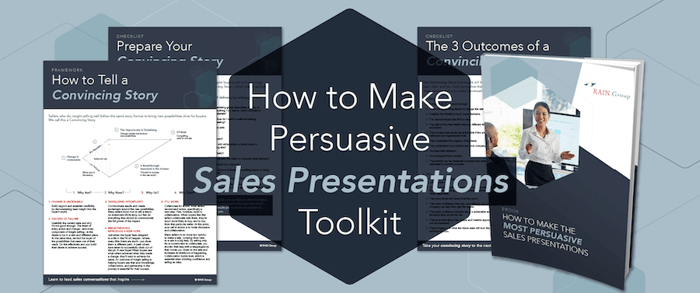As one of the final steps to close a sale, the proposal presentation is essential to answering lingering questions, demonstrating impact, and connecting with decision makers.
While there are several things to keep in mind for the presentation itself, just as important is the preparation you do before the meeting. Asking key questions of your buyer and working with your internal team will give you the edge you need to outshine your competition.
Done well, a proposal presentation builds rapport, deepens trust, and serves as an experiential sample of what the buyer will get if they work with you.
Below we share 13 tips to help build your confidence and increase the chances that you nail your next proposal presentation.
Deliver Winning Sales Presentations |
|
Before the Presentation
|
During the Presentation
|
Before the Presentation
1. Know the players
You should ask your champion or key contact about the meeting participants on their side. Focus on what they’ll want to hear and how they’ll want the conversation to go.
An important factor is the desired balance between presentation/monologue and dialogue/collaboration. If you can’t get this information, prepare a blend of monologue and dialogue and be ready to calibrate as you go.
Dialogue is typically better than monologue, as it affords opportunities to connect and collaborate with buyers. Most people feel more connected to sellers who lead a good conversation and don’t just talk for an hour.
2. Do some sleuthing
Remember, you're not the star of your presentation—the buyer is! Make sure you know what’ll resonate with them in what you say and how you say it. Look up presentation participants using LinkedIn, Google, and other research tools. Make note of professional activities, publications, awards, and so on.
Keep in mind that most buyers will also be looking you up before the meeting, so make sure you project professionalism and demonstrate value on your public profiles.
Download our LinkedIn for Sales Guide. >>
3. Define your roles
Define the roles of your presentation team. You might have someone play the emcee, have three area experts, or bring a support team to introduce and build rapport.
But having three leaders means there are no leaders. If it’s clearly you, great. But if there could be others, ensure there’s one person in charge of making sure everything comes together and holding others accountable. Whatever the roles are, make sure they’re clear.
4. Involve everyone
If multiple people are coming to the presentation, everyone must participate. Often, buyers will mention after presentations that they didn’t pick one of the providers because one team member was too dominant and everyone else was too silent.
One person may talk the most, but everyone needs a role if you bring them, even if it’s just introductions and after-meeting chat.
5. Ask about logistics
You need to know all the logistics to make sure the meeting runs smoothly. Ask yourself, your team, and the buyer the following questions:
- Where is the meeting taking place?
- Where are all the participants based?
- Is the meeting live and will anyone be joining virtually?
- Are there printed or physical materials that need to be emailed to remote attendees in advance?
- How much time is allotted for the meeting? Are there hard start/stop times or tech checks?
- What technology platform are you using? If possible, use yours. You’re used to it, and you’ll have more control over the process.
6. Dress the part
Your outfit is part of your planning. Find out how formal or casual the buyer’s culture is. If you’re presenting to a major financial services firm with a white-shirt-and-suit culture, you won’t want to show up to deliver in jeans and a polo—you’ll lose the sale before you even start talking.
On the flip side, if you go with a suit with some tech companies, you might just turn off people used to a more casual atmosphere. Whatever the case, know your buyer.
7. Present well
Make sure presenters have the general capability to command a room. If they don’t, and the presentation is critical, have someone else present.
If the person presenting isn’t world-class, practice the delivery in-house with overly critical attendees. Let the presenter make mistakes and correct them before the meeting—not in front of the actual buying team.
8. Be strategic
Not every finalist presentation is a competition against others, but they usually are. If you’re facing competition, find out who they are by asking the buyer.
If your buyer won’t tell you, and you have a champion inside the organization, ask them discreetly. If you can’t find out who the competition is, you can often find out about the presentation timing.
If all presentations are on same day, it’s usually best to go first. Research shows that, on the same day, whoever goes first is the benchmark that everyone else is judged against, and they’re remembered most. This is called the primacy effect.
If presentations are on different days, it’s best to go last. As time passes, people will remember—and feel most connected to—the final presentation. This is the recency effect.
During the Proposal Presentation
9. Build rapport
Attend to the basics of good meeting etiquette with some of the following actions:
- Extend greetings
- Make eye contact
- Break the ice
- Be prepared to make small talk
Have a few conversational tidbits at the ready to share. This can help “warm up” your buyers and establish feelings of camaraderie and trust.
Read How to Build Rapport in Sales. >>
10. Start off on the right foot
Lead the transition into the agenda and kick off the meeting. Share an introduction that includes why you’re meeting and sets expectations. It’s not unusual for meetings to go awry when people don’t know why they’re there—or think they’re there for different reasons.
You might also get their input by asking if there’s anything in particular they’d like you to address by the time the presentation is done. The more you know, the more you can tailor the discussion to their agenda and desires.
11. Invite participation
Set the stage for buyers to be active participants in the process, not passive listeners. Ask them to dive in with thoughts and questions at any time. And be sure to confirm the time available. That way, you can adjust to any changes, whether that means early departures or even additional time.
Before you begin your presentation, once again invite interruptions or questions to make it a conversation. You want to get your points across, but the best discussions often aren’t linear and don’t involve you talking at the buyer. If you’re interrupted, you’ll know buyers are engaged.
12. Be persuasive
It’s one thing to know your impact model and another to be able to communicate your point of view and impact convincingly. Ask yourself the following questions:
- Can you tell a Convincing Story?
- Can you shake up the status quo with provocative questions?
- Can you see how what you’re advocating for will affect the rest of the buyer’s business?
Sellers who aren’t prepared to influence buyers and present persuasively have a difficult time getting results.
 Have you ever delivered a sales presentation that fell flat? You aren't alone. Get the resources you need lead collaborative presentations that win in our How to Make Persuasive Sales Presentations Toolkit. Download now. >>
Have you ever delivered a sales presentation that fell flat? You aren't alone. Get the resources you need lead collaborative presentations that win in our How to Make Persuasive Sales Presentations Toolkit. Download now. >>13. Share stories
Case studies can be critically important in helping you close the sale. Use previous customer examples—anonymized or in aggregate if the data is sensitive or proprietary—to illustrate the positive impact of your product or service.
Showing similar impact through case studies and stories builds credibility and belief you’ll deliver what you say you can. The stronger you can make your case, the more likely it is that you’ll close the sale.
Read 50 Powerful Sales Questions. >>
Get the Slide Deck
Take these tips on the go or share them with your team. Download the PDF here.





